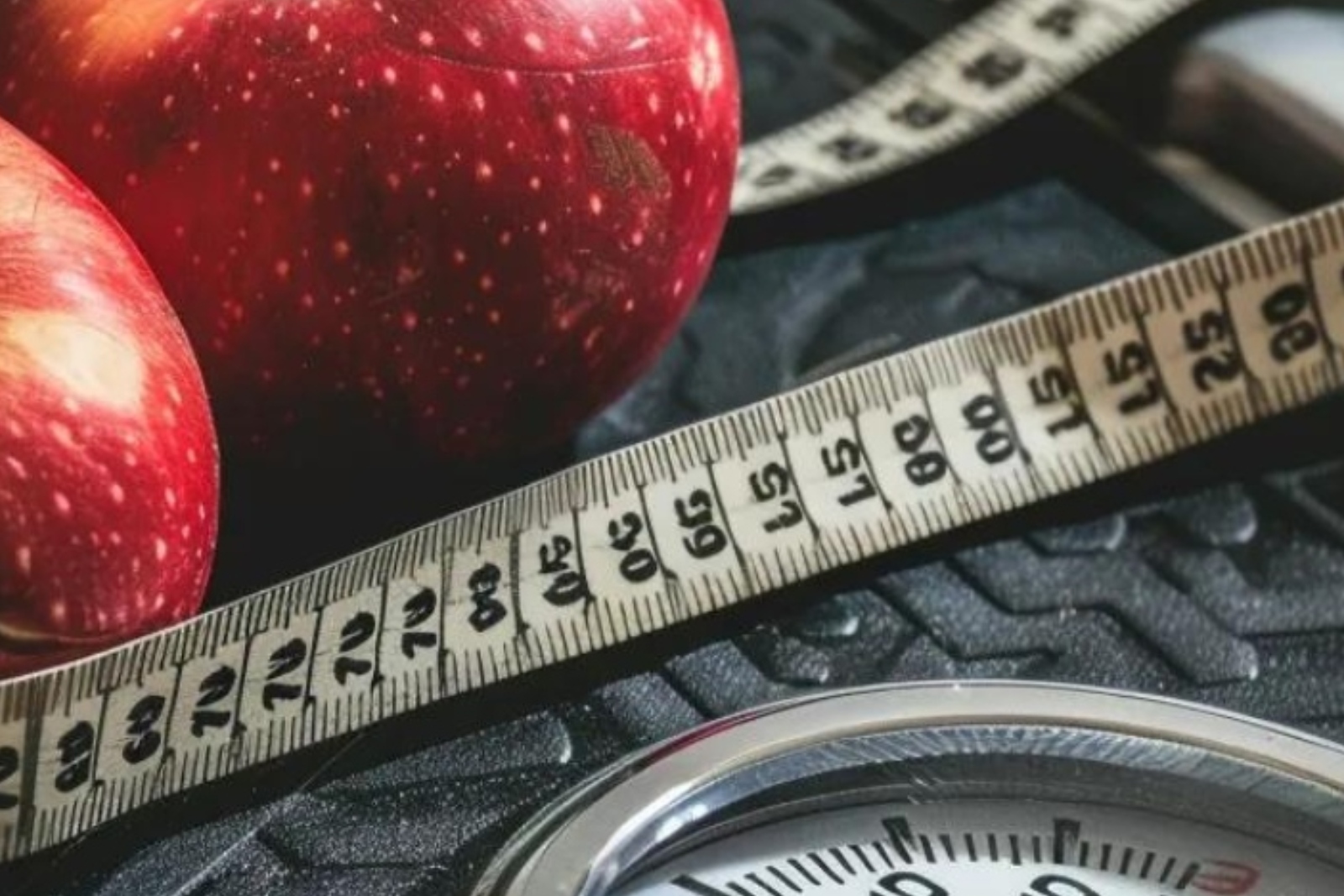
The 50% rule for weight loss reduces portions and habits by half instead of removing them completely. This method helps people lose weight without extreme restrictions or metabolic damage that commonly occurs with crash dieting approaches.
Research shows that drastic calorie cuts can lower metabolic rate up to 23%. The 50% rule prevents this slowdown by making gradual changes that keep hunger hormones balanced and maintain steady energy levels throughout the weight loss process.
What Does The 50% Rule Mean For Weight Loss?
The 50% rule means cutting food portions, unhealthy habits, or behaviors in half rather than eliminating them entirely. People eat half their usual pasta serving and add vegetables. They drink one soda instead of two daily. They exercise 15 minutes instead of skipping workouts completely.
This approach works because the brain sees change as choice, not punishment. Traditional diets trigger survival mode where the body fights back against restriction. The 50% rule allows natural adaptation without metabolic rebellion or intense psychological resistance.
The concept applies to multiple areas of daily life. Food portions get reduced by exactly half while maintaining favorite foods. Physical activity increases by 50% from current levels rather than demanding perfect exercise routines. Unhealthy habits decrease gradually instead of stopping overnight.
How The 50% Rule Differs From Traditional Diets
Traditional diets demand complete elimination while the 50% rule requires only reduction. Standard weight loss plans remove entire food groups like carbs or sugar. The 50% rule keeps all foods but reduces quantities to create sustainable calorie deficits.
Studies show that over 80% of lost weight returns within five years using extreme methods. The 50% rule creates sustainable habits that last longer because people never feel completely deprived of foods they enjoy.
Traditional diet approaches create all-or-nothing thinking patterns. One mistake ruins the entire plan. The 50% rule encourages flexibility where imperfect days still represent progress toward weight loss goals.
Why Does The 50% Rule Work For Weight Loss?
The 50% rule works because it prevents metabolic slowdown and maintains stable hunger hormones. The human body resists rapid changes by slowing metabolism and increasing hunger signals to protect against perceived starvation.
Gradual weight loss preserves more muscle mass and resting metabolic rate compared to rapid weight loss. Research from the British Journal of Nutrition confirms that people who lose weight slowly maintain better fat loss and metabolic function over time.
Small changes become automatic faster than large changes according to habit formation research. The brain requires approximately 66 days to form new automatic behaviors, but simple changes like portion reduction happen much quicker than complex diet overhauls.
What Hormones The 50% Rule Affects
The 50% rule balances ghrelin and leptin, the two main hunger hormones that control appetite and satiety. Ghrelin signals hunger while leptin signals fullness to the brain. Extreme diets disrupt these hormones and cause intense cravings that lead to diet failure.
Small portion reductions keep hormone levels stable throughout the day. People experience fewer cravings and better appetite control without the dramatic hunger spikes common with restrictive dieting approaches. This hormonal balance supports long-term weight maintenance after initial weight loss.
Cortisol levels also remain more stable with gradual changes. High cortisol from diet stress promotes fat storage around the midsection and increases cravings for high-calorie comfort foods.
The Science Behind Metabolic Preservation
The 50% rule prevents adaptive thermogenesis, where the body reduces calorie burning in response to severe restriction. This survival mechanism helped humans survive famines but makes modern dieting extremely difficult.
When calorie intake drops gradually, the metabolism adjusts slowly and maintains higher baseline function. People burn more calories at rest and during activity compared to those who use extreme calorie restriction methods.
Muscle protein synthesis continues normally with adequate nutrition from 50% portion reductions. Extreme dieting forces the body to break down muscle tissue for energy, which permanently reduces metabolic rate and makes weight maintenance nearly impossible.
How Do You Apply The 50% Rule Daily?
Apply the 50% rule by reducing current portions and habits by exactly half. Start with one meal or snack per day to avoid overwhelming yourself with too many changes simultaneously. Use smaller plates for automatic portion control that tricks the brain into feeling satisfied with less food.
Replace half of any high-calorie food with vegetables or lean protein to maintain satiety while reducing overall calorie intake. This strategy prevents the hunger and energy crashes common with simple calorie restriction.
Mental health considerations play an important role in successful implementation. People with anxiety around food changes should start even smaller, perhaps reducing portions by 25% initially before progressing to the full 50% reduction.
What Foods Work Best With The 50% Rule
High-calorie, low-nutrient foods respond best to 50% reduction strategies. These include pasta, bread, chips, desserts, and sugary drinks that provide significant calories without essential nutrients. People keep the foods they enjoy while reducing calorie intake naturally.
Refined carbohydrates work particularly well for this approach. Half a bagel with cream cheese plus scrambled eggs provides satisfaction while cutting calories significantly. Half a pizza slice with a large salad creates a balanced meal that feels complete.
Sugary beverages offer easy wins with the 50% rule. Cutting from two sodas to one daily eliminates approximately 300 calories without major lifestyle changes. Mixing juice with sparkling water reduces sugar intake while maintaining flavor satisfaction.
The key involves replacing reduced portions with nutrient-dense alternatives. Half the usual rice serving plus extra vegetables maintains plate fullness while improving nutrition quality and reducing calories simultaneously.
How To Increase Movement By 50%
Increase daily movement by 50% from current activity levels rather than jumping into intense exercise programs. Sedentary people add 10-minute walks after meals. Active people extend workouts by 15 minutes or add one extra exercise day weekly.
Small movement increases burn more calories long-term than occasional intense workouts that cause burnout and inconsistency. Consistency matters more than intensity for sustainable weight loss and long-term health improvements.
Primary care providers can help determine appropriate exercise increases for people with existing health conditions or physical limitations that affect safe activity levels.
What Are The Different Types Of 50% Rules?

Four main types of 50% rules exist for weight loss: portion reduction, habit improvement, macronutrient targets, and exercise balance. Each approach focuses on different aspects of weight management while maintaining the core principle of gradual change.
The portion reduction method cuts all food servings in half and replaces missing calories with vegetables or lean protein. The habit improvement approach focuses on making 50% of daily food choices healthier without measuring exact portions.
The Portion Reduction Method
The portion reduction method cuts all food servings in half and replaces missing calories with vegetables that provide volume and nutrients. Fill half the plate with non-starchy vegetables like broccoli, spinach, bell peppers, and cauliflower. Fill the other half with protein and whole grains in reduced portions.
This creates automatic calorie reduction while maintaining nutrition and satisfaction. The visual full plate prevents feelings of deprivation that sabotage traditional calorie restriction approaches.
Practical implementation involves using smaller dishes and bowls to make reduced portions appear larger. The brain associates full plates with adequate meals, regardless of actual plate size used for serving.
The Habit Improvement Approach
The habit improvement approach focuses on making 50% of daily food choices healthier without strict portion measurement. People who make 10 food decisions daily aim to improve 5 of them. This removes pressure for perfection while creating meaningful change over time.
Examples include choosing grilled chicken over fried chicken for lunch, selecting fruit over cookies for afternoon snacks, or drinking water instead of soda with dinner. Small wins build confidence for continued progress.
This method works well for people who resist strict rules or measurement requirements. The flexibility prevents the rebellion response common with rigid diet structures while still creating calorie deficits necessary for weight loss.
The 50-50 Exercise Rule
The 50-50 exercise rule alternates equal time between cardio and strength training within single workout sessions. A 30-minute workout includes 15 minutes cardio and 15 minutes resistance exercise. This provides benefits of both exercise types without requiring separate workout days.
Cardio burns immediate calories and improves heart health. Strength training builds muscle mass that increases resting metabolic rate for ongoing calorie burn throughout the day and night.
This balanced approach prevents the muscle loss common with cardio-only exercise programs during weight loss phases. Maintaining muscle mass supports long-term metabolic health and makes weight maintenance easier after reaching goal weights.
What Benefits Does The 50% Rule Provide?
The 50% rule provides sustainable weight loss, prevents muscle loss, reduces food obsession, and improves psychological relationship with eating. Small changes become automatic faster than large changes according to extensive habit formation research conducted by behavioral scientists.
Studies show that people using gradual approaches lost an average of 3.8 kg at 32 weeks follow-up. Behaviors became second nature and felt automatic rather than forced or difficult to maintain over extended time periods.
The psychological benefits include reduced guilt around food choices and decreased anxiety about perfect adherence to complex diet rules. People report feeling more relaxed about eating while still achieving consistent weight loss progress.
How The 50% Rule Prevents Muscle Loss
The 50% rule prevents muscle loss by avoiding extreme calorie restriction that forces the body to break down muscle tissue for energy. Rapid weight loss causes both fat and muscle loss, which reduces metabolic rate and makes weight maintenance difficult.
Gradual reduction preserves lean body mass and metabolic rate throughout the weight loss process. Research confirms that gradual weight loss maintains more muscle tissue compared to crash dieting methods that promise quick results.
Protein intake remains adequate with the 50% rule because people still eat regular meals with reduced portions rather than skipping meals entirely. Adequate protein supports muscle preservation during calorie deficits.
Why The 50% Rule Reduces Food Cravings
The 50% rule reduces cravings because no foods are completely forbidden or eliminated from daily eating patterns. Complete restriction increases psychological desire for banned items through the psychological reactance effect.
Partial reduction satisfies both physical and mental food needs without triggering the deprivation mindset that leads to binge eating episodes. People report fewer intense cravings and less guilt around occasional indulgences.
The brain interprets partial restriction as temporary inconvenience rather than permanent threat. This prevents the survival response that increases hunger hormones and slows metabolism with extreme dieting approaches.
Who Should Use The 50% Rule For Weight Loss?
The 50% rule works best for people who failed with extreme diets, busy individuals, and emotional eaters who struggle with food restriction anxiety. This method requires no calorie counting, food weighing, or complex meal planning that interferes with normal daily routines.
Busy professionals appreciate the simplicity of halving portions without learning new cooking skills or shopping for special diet foods. Parents find it easier to model healthy eating for children without creating separate family meals.
People with histories of yo-yo dieting benefit from the sustainable approach that prevents the metabolic damage associated with repeated extreme weight loss and regain cycles.
What Types Of People Benefit Most
People with previous diet failures, busy schedules, and food relationship issues benefit most from the 50% rule approach. The flexible method reduces stress and guilt while creating sustainable habits that fit into existing lifestyle patterns.
Those wanting gradual change over quick results find long-term success with this method. Perfectionists who struggle with all-or-nothing thinking appreciate the built-in flexibility that allows imperfect days without complete plan abandonment.
Social eaters who attend frequent dinners or workplace events can apply the 50% rule without drawing attention to special dietary requirements that might create social awkwardness or pressure from others.
When Someone Should Avoid The 50% Rule
People with significant medical conditions or eating disorders should consult healthcare providers before using the 50% rule independently. Diabetes, heart disease, and mental health conditions may require specialized approaches with professional medical supervision.
Those with histories of restrictive eating disorders might interpret portion reduction as permission to return to problematic restrictive patterns. Mental health evaluation can help determine appropriate weight loss strategies for people with complex psychological relationships with food and eating.
Active eating disorder symptoms require treatment before attempting any weight loss methods, including seemingly gentle approaches like the 50% rule that might trigger unhealthy behaviors.
What Mistakes Do People Make With The 50% Rule?
Common mistakes include not planning replacement foods, being too rigid with exact measurements, and ignoring hunger signals that indicate inadequate nutrition. Cutting portions without adding vegetables or lean protein leaves people hungry and prone to overeating later.
Some people interpret the 50% rule as license to eat anything as long as portions are smaller. This misses the importance of nutrition quality and can slow weight loss progress significantly.
Others become obsessed with exact measurements and turn the flexible 50% rule into another rigid diet system that creates stress and anxiety around food choices.
How To Avoid 50% Rule Mistakes
Avoid mistakes by planning healthy replacements, staying flexible with measurements, and listening to genuine hunger cues throughout the day. If authentic hunger persists after portion reduction, add more vegetables or lean protein rather than ignoring physical needs.
Focus on overall pattern improvement rather than perfect adherence to exact 50% measurements. Some days might involve 40% reduction while others achieve 60% reduction. The average over time matters more than daily precision.
Depression treatment might be necessary for people who experience significant mood changes with any dietary modifications, as mental health affects eating behaviors and weight loss success rates.
How Do You Combine The 50% Rule With Other Strategies?
Combine the 50% rule with adequate sleep, stress management, and proper hydration for optimal weight loss results. Poor sleep affects hunger hormones ghrelin and leptin, making portion control significantly more difficult.
Chronic stress increases cortisol production which promotes fat storage around the midsection and increases cravings for high-calorie comfort foods. Stress management prevents these physiological responses that interfere with weight loss progress.
What Role Sleep Plays In The 50% Rule
Quality sleep supports 50% rule success by regulating appetite hormones that control hunger and satiety signals. Adults need 7-9 hours of sleep nightly for optimal hormone balance and metabolic function.
Sleep deprivation increases ghrelin production which stimulates appetite, while simultaneously decreasing leptin which signals fullness to the brain. This hormonal imbalance makes portion control nearly impossible and increases cravings for high-calorie foods.
People who prioritize sleep quality report easier adherence to portion reduction strategies and more consistent energy levels throughout weight loss phases.
How Stress Affects The 50% Rule
High stress levels can sabotage 50% rule effectiveness through increased cortisol production that promotes fat storage and increases appetite for comfort foods. Stress hormones override rational portion control decisions and trigger emotional eating patterns.
Chronic stress also disrupts sleep quality, creating a cycle where poor sleep increases stress hormones and stress prevents quality sleep. This cycle makes weight loss significantly more challenging regardless of eating strategies used.
Practice daily stress reduction through deep breathing exercises, meditation, gentle physical activity, or hobbies that provide mental relaxation and emotional balance.
What Does A Sample 50% Rule Day Look Like?
A sample day includes half portions at main meals plus one daily habit change that supports weight loss goals. Breakfast uses half the usual cereal amount with extra fresh berries for sweetness and fiber. Lunch includes half a sandwich with a full salad for volume and nutrients.
Dinner features regular protein portions with half the usual carbohydrate serving plus extra vegetables to maintain plate fullness and nutritional adequacy. Evening snacks get reduced by half or replaced with lower-calorie alternatives like fruit or vegetables.
Daily activity increases by simple additions like taking stairs instead of elevators once daily, parking farther from destinations, or adding 10-minute evening walks after dinner instead of immediate television watching.
Morning Routine With The 50% Rule
Start the day with half the usual breakfast cereal or oatmeal portion, adding extra fruit for natural sweetness and fiber. Replace half the milk with unsweetened almond milk to reduce calories while maintaining creamy texture.
Coffee drinkers can use half the usual sugar or creamer amounts, gradually reducing sweetness tolerance over time. Green tea provides caffeine with metabolism-boosting compounds and zero calories.
Morning exercise increases by 50% from current levels. Non-exercisers add 10-minute morning walks. Regular exercisers extend workouts by 15 minutes or add one extra day weekly.
Afternoon And Evening Applications
Lunch portions get reduced by half while doubling vegetable intake for volume and nutrients. Half a sandwich with soup or salad creates satisfying meals without excess calories from large portions.
Afternoon snacks get portioned into small bowls rather than eating directly from packages. This natural portion control prevents mindless overeating while still allowing favorite treats.
Evening meals focus on regular protein servings with reduced carbohydrate portions and increased vegetable intake. This maintains muscle-preserving nutrition while creating calorie deficits for weight loss.
How Do You Maintain Long-Term Success With The 50% Rule?
Long-term success requires building on initial progress and avoiding weight regain patterns that affect most people who lose significant weight. Once half portions feel natural and automatic, people can make additional gradual improvements without overwhelming themselves.
Research shows that sustainable behavioral changes take an average of 66 days to become automatic habits. The 50% rule creates lasting behavioral patterns rather than temporary restrictions that end when goal weights are achieved.
Continued self-monitoring helps maintain awareness of portion sizes and eating patterns without obsessive tracking that characterizes problematic diet approaches. Simple awareness prevents gradual portion creep that leads to weight regain over time.
What Prevents Weight Regain
Continued self-monitoring and flexible thinking prevent weight regain after initial weight loss success. People who maintain weight loss long-term track their habits and adjust strategies as needed without rigid adherence to perfect behaviors.
Regular weight checks help identify small increases before they become significant regain. Weekly or monthly weigh-ins provide feedback without daily scale obsession that can create anxiety and emotional eating responses.
Social support from family members or friends who understand healthy eating goals provides encouragement during challenging periods when motivation decreases naturally.
When Should You Seek Professional Help?

Seek professional help if medical conditions exist, mental health issues persist, or weight loss progress stalls completely after several months of consistent effort. Healthcare providers can identify underlying metabolic issues or medication effects that interfere with weight loss.
ADHD treatment might be necessary for people who struggle with consistent habit implementation due to attention difficulties that affect meal planning and portion awareness.
Thyroid disorders, insulin resistance, and hormonal imbalances can slow weight loss progress despite perfect adherence to portion control strategies. Blood testing can identify these issues that require medical treatment alongside lifestyle changes.
What Medical Conditions Affect The 50% Rule
Diabetes requires careful carbohydrate monitoring that might conflict with flexible portion reduction approaches. Medication management becomes crucial when changing eating patterns that affect blood sugar control medications.
Heart conditions might limit appropriate exercise increases, requiring professional guidance to determine safe activity levels for individual circumstances and current fitness levels.
Eating disorder histories require careful screening before attempting any portion control strategies that might trigger restrictive behaviors or unhealthy relationships with food and eating.
Signs You Need Professional Support
Weight loss plateaus lasting longer than 6 weeks despite consistent 50% rule application may indicate metabolic adaptation or underlying health issues. Professional evaluation can identify hormonal imbalances or medication side effects.
Mood changes, extreme fatigue, or obsessive thoughts about food and weight indicate need for mental health support alongside weight loss efforts. Healthy weight loss should improve energy and mood, not create psychological distress.
Rapid weight loss exceeding 2 pounds weekly might indicate the 50% rule is being applied too aggressively. Professional guidance prevents nutritional deficiencies and metabolic damage from excessive restriction.
How Does Age Affect The 50% Rule?
Age affects metabolic rate and muscle mass, which influences how quickly the 50% rule produces visible weight loss results. Older adults might need longer time periods to see significant changes compared to younger people with faster metabolisms.
Hormone changes during menopause can slow weight loss progress in women, requiring patience and consistency with portion reduction strategies. Testosterone decline in older men similarly affects metabolism and muscle maintenance during weight loss.
Joint problems common in older adults might limit exercise increases, requiring focus on dietary changes rather than balanced diet and exercise approaches used by younger people.
Age-Related Considerations For Success
Older adults benefit from slower implementation of the 50% rule to allow bodies time to adjust to changes. Starting with 25% portion reductions for several weeks before progressing to 50% prevents metabolic shock.
Protein needs increase with age to preserve muscle mass during weight loss. Older adults should prioritize protein portions while reducing carbohydrate and fat portions for optimal body composition results.
Regular medical monitoring becomes more important with age, as underlying conditions like diabetes or heart disease require professional oversight during weight loss efforts.
Frequently Asked Questions
How Long Does It Take To See Results With The 50% Rule?
Most people see initial weight loss within 2-3 weeks of consistently applying the 50% rule. Significant results typically appear after 8-12 weeks of consistent portion reduction and habit changes.
Can You Use The 50% Rule If You Have Diabetes?
People with diabetes can use the 50% rule but should consult healthcare providers first. Blood sugar medications may need adjustment when changing eating patterns and portion sizes.
Does The 50% Rule Work Without Exercise?
The 50% rule works through dietary changes alone, but adding 50% more movement accelerates results. Even small increases like 10-minute daily walks enhance weight loss progress.
What Happens If You Eat More Than 50% Sometimes?
Occasional days with larger portions will not ruin progress. Focus on overall weekly patterns rather than perfect daily adherence to 50% measurements.
Is The 50% Rule Safe For Everyone?
The 50% rule is safe for most healthy adults but people with eating disorders, serious medical conditions, or those taking medications should seek professional guidance before starting.
Final Thoughts
The 50% rule offers a sustainable alternative to extreme dieting through gradual portion and habit reduction that respects natural body functions. This method prevents the metabolic damage and psychological stress associated with restrictive dieting while still creating meaningful weight loss results.
Success comes from consistent progress rather than perfect adherence to exact measurements or rigid rules. Start with one 50% reduction today, whether reducing afternoon snack portions or adding a 10-minute walk after dinner.
For comprehensive support that addresses both physical and mental health aspects of weight loss, telehealth services provide convenient access to professional guidance that combines medical expertise with practical lifestyle strategies for sustainable results.

.png)
.png)
.png)



.png)
.png)
.png)



.png)

.png)
